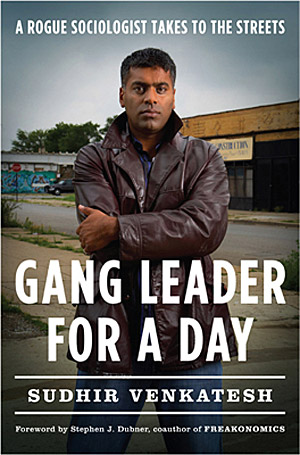 A couple of years ago I read Stephen Levitt’s fascinating book Freakonomics
A couple of years ago I read Stephen Levitt’s fascinating book Freakonomics. One of the most interesting themes covered was the economics of a drug selling gang in Chicago. Levitt had access to a couple of years of ledger books detailing the income and expenses for one particular chapter of the Black Knights gang. The person who gave him these ledger book was Sudhir Venkatesh who spent a couple of years doing research in the Robert Taylor Homes.
Venkatesh has now written a book about his time in the “projects”: Gang Leader for a Day: A Rogue Sociologist Takes to the Streets. This book is very interesting on many different levels. In the beginning of the book he accidentally gets into contact with a gang leader, J.T., who is strangely willing to have Venkatesh tag along and lets him in on the secrets of gang life. He visits the neighbourhood over a period of years, gradually expanding the number of people who trust him and are willing to share their story with him.
Throughout the book he struggles with his research methodology. He is convinced that doing traditional quantitative research using objective surveys does not lead to any deep insights into why it is so hard for many people to get out of poverty and how it is that people do manage to struggle along. On the other hand his participatory research is also troublesome. What is he to do when he witnesses the gang planning or doing illegal activities? How does he earn people’s trust? He notices that by observing all kind of hustlers and trying to get to know as much about them as possible, he himself is also slowly turning into a hustler: a hustler for information.
I was surprised to find out how much of the drug trade is run as a normal business. Most of J.T.’s problems and dilemma’s are managerial. His actions and behaviour on the street are all in the interest of selling more drugs and keeping their customers happy.
There are a couple of parallels between the Robert Taylor Homes in Chicago and the “Bijlmer” area (Amsterdam South-East) where I have been working as a teacher for several years. The sense of community where people know each other and look out for each other is very recognisable. They also share the failure of the urban renewal programs in the 60’s and 70’s. From the book:
From the outset urban renewal held the seeds of its own failure. White political leaders blocked the construction of housing for blacks in the more desirable white neighborhoods. And even though blighted low-rise buildings in the ghetto were replaced with highrises like the Robert Taylor Homes, the quality of the housing stock wasn’t much better. Things might have been different if housing authorities around the country were given the necessary funds to keep up maintenance on these new buildings. But the buildings that had once been the hope of urban renewal were already, a short forty years later, ready for demolition again.
This is exactly what happened in the Bijlmer. Looking back, it is hard to understand how the nearly ideological architectural ideas behind the highrises that were built with expansive empty spaces between them weren’t seen as the complete failures that they turned out to be. I’ll revisit this theme in a post in the future.